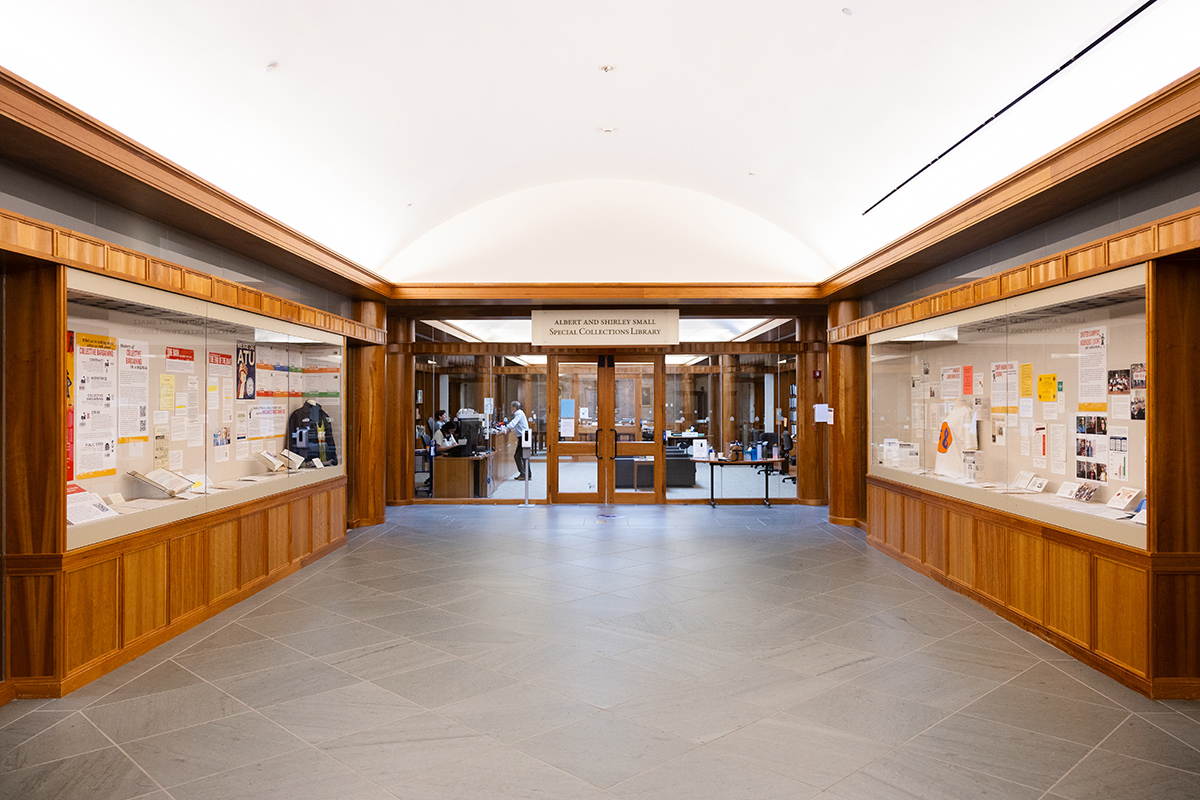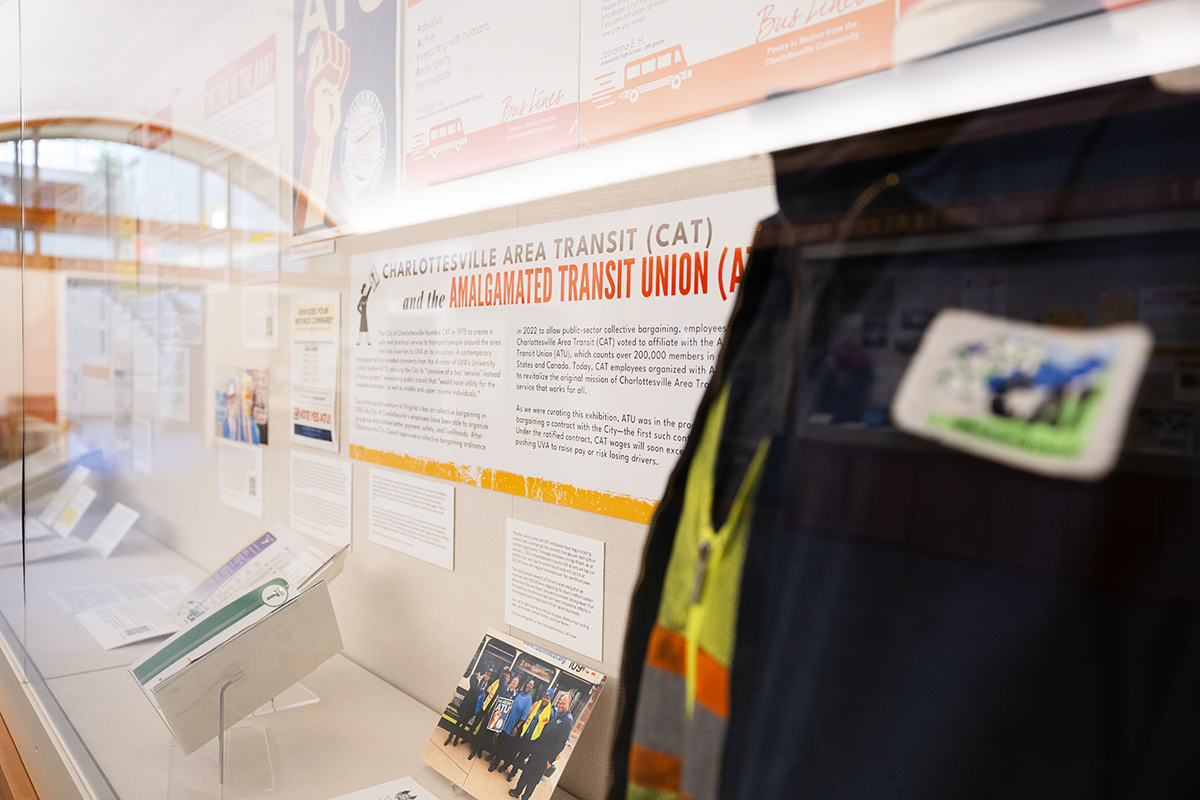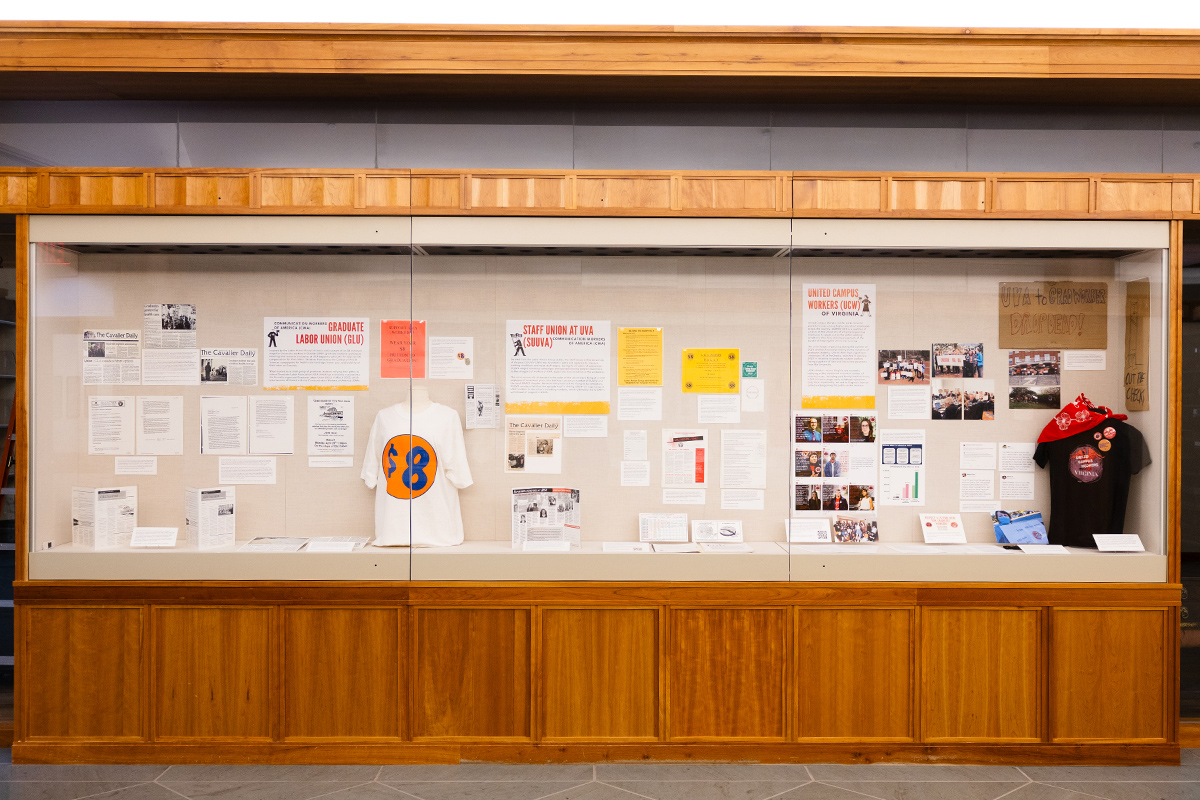 When first-year students signed up for Piers Gelly’s course to fulfill their required ENWR class credits for fall 2023, they had no idea that they’d soon become the only group of first-year students to curate an exhibition at UVA Library.
When first-year students signed up for Piers Gelly’s course to fulfill their required ENWR class credits for fall 2023, they had no idea that they’d soon become the only group of first-year students to curate an exhibition at UVA Library.
The exhibition, “Collective Bargaining for the Common Good,” runs through June 20 in the First Floor Gallery of the Albert and Shirley Small Special Collections Library. The exhibition amplifies 22 years of labor advocacy at UVA and in the Charlottesville area, ongoing through this day.
Collective Bargaining remains an engaging topic in Virginia — one of only three states where, until 2021, a state-wide ban (instituted as segregationist policy at UVA in the 1940s) prohibited collective bargaining by public-sector unions. Gelly, who floated the exhibition as an optional project at the end of required coursework, said: “I’ve just been so proud of these students the whole time. I don't take it for granted that they didn't really choose to be in my class; they just ended up there by virtue of where they fall in the alphabet, and when their schedule was open. So for them to take a chance … and follow a project like this, not only through this semester, but then to sign on to the exhibition after this semester — I have so much admiration for them.”
Gelly’s class, ENWR 1510: Writing About Labor, is one of many writing and rhetoric classes offered to first-year students under broad umbrellas like “Writing About Nature” or “Writing About Society,” where they learn to research and write at a college level. Librarians Jacob Hopkins, Cecelia Parks, and Sherri Brown assisted in the classroom as Gelly’s students learned how to request and analyze Special Collections materials and Library holdings like archival newspapers and microfilm collections.
“Within the context of the class, the final project was to create a trifold poster board, so sort of science fair vibes,” Gelly said. Students worked with Library curator Holly Robertson to learn the basics of presenting archival materials, including concise exhibition writing and visual design considerations.
But Gelly saved a surprise for the end: “All of the students finished up this semester, having created a DIY museum — and they didn't know until the last day of class that there was going to be an actual Special Collections exhibition. I was very strategic in when I gave them information, so that they weren't overwhelmed.” When Gelly told his students about the plan for a formal exhibition, eight students chose to sign on. With support from the Library’s Wolfe Fellowship — funded by Mary Lacey Long Wolfe (Col ‘88), a former Library student assistant, to support student docent and curatorial work in Library exhibitions — a cohort of eight students divided into four groups to work with primary source materials as well as local community advisors who are current or former members of labor unions at UVA or in Charlottesville.
Student curators Drew Dillman and Kim Egoavil partnered with community members from Charlottesville Area Transit (CAT) as they recently joined the Amalgamated Transit Union (ATU); Samantha Bragg and Elizabeth Campbell worked with current and former staff leaders to chronicle the Staff Union at UVA (SUUVA); Hank Hawkins and Pearl Kluger searched the country to locate former UVA graduate students and document the activism of the Graduate Labor Union (GLU); and Katherine Jennings and Karen Guzman researched the recent formation of the UVA chapter of United Campus Workers of Virginia.
Gelly’s work on this exhibition is also supported by an Open Education Resources (OER) Affordability and Equity Grant administered by the UVA Library. Given the significant presence of Special Collections materials in Gelly’s proposed OER project, Library Director of Faculty Programs Judy Thomas recommended that they begin a conversation with Library curation teams about a potential exhibition. Gelly’s OER project will culminate not only in this ambitious, student-curated exhibition, but also in the creation of an OER resource in the form of a catalog that captures the research and curation on the history of labor organizing and collective bargaining at the University of Virginia and in Charlottesville.
The student curators were driven by the power of the primary source material and the compelling stories of their community advisors. Pearl Kluger said, “I think if there’s one thing visitors should take away, it’s the passion behind labor unions, because every single person, every single former member of Graduate Labor Union that we spoke to was so passionate about their experience. … I hope that our exhibition carries the passion behind this movement.”
While students learned to conduct advanced research, using tools like microfilm to comb archival records, they also sought out relevant contemporary experiences such as attending a Charlottesville City Council meeting. In the meeting, members of the Amalgamated Transit Union, which covers Charlottesville bus drivers, advocated for fairer terms in their first-ever collectively bargained contract. This was only possible due to an ordinance passed in 2022 to allow collective bargaining for Charlottesville City employees.
Drew Dillman reflected on the living history in the exhibition: “It’s centered on the people involved. We got to meet these people, the actual people involved, and they are the heart and soul of this exhibition.”
“Collective Bargaining for the Common Good,” on view until June 20, conveys a riveting picture of that history and the labor movement — its past, its present, and perhaps even its future.
On Friday, April 26, Gelly and his students will present a gallery talk on the exhibition during a Special Collections Final Friday event. Visitors can also enjoy Kona Ice and screenprint “Collective Bargaining for the Common Good” T-shirts with local artist Thomas Dean. The event runs from 5:30-7 p.m. in the Small Special Collections Library, located at 170 McCormick Road.



